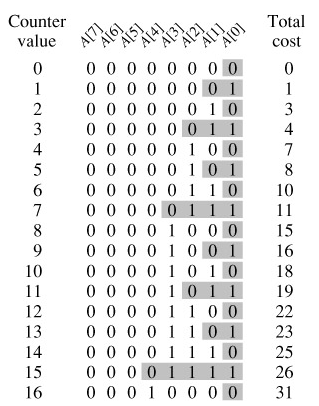Aggregate Analysis

As with the stack example, a cursory analysis yields a bound that is correct but not tight. A single execution of INCREMENT takes time Θ(k) in the worst case, in which array A contains all ′s. Thus, a sequence of n INCREMENT operations on an initially zero counter takes time O(nk) in the worst case.
We can tighten our analysis to yield a worst-case cost of O(n) for a sequence of n INCREMENT's by observing that not all bits flip each time INCREMENT is called. As Figure 17.2 shows, A[0] does flip each time INCREMENT is called. The next-highest-order bit, A[1], flips only every other time: a sequence of n INCREMENT operations on an initially zero counter causes A[1] to flip ⌈n/2⌉ times. Similarly, bit A[2] flips only every fourth time, or ⌈n/4⌉ times in a sequence of n INCREMENT's. In general, for i = 0, 1, ..., ⌈lg n⌉, bit A[i] flips ⌈n/2i⌉ times in a sequence of n INCREMENT operations on an initially zero counter. For i > ⌈lg n⌉, bit A[i] never flips at all. The total number of flips in the sequence is thus

The worst-case time for a sequence of n INCREMENT operations on an initially zero counter is therefore O(n). The average cost of each operation, and therefore the amortized cost per operation, is O(n)/n = O(1).